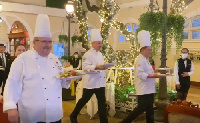Association of Hungarian National Values and Hungarikums
(National organization)
The Association
The Association
| President: | Imre Pesti MD |
| Vice President: | Béla Prohászka |
| Managing Director: | Zoltán Kázmér Szabó |
Our Mission:
Our Mission is to cooperate with regional and local governments across every related sector and to reach out to the Hungarian communities abroad in order to promote the traditional Hungarian values.
The Association also seeks areas of engagement with every non-governmental organization, association, and company sharing the principles described above.
Principle:
The Association supports the value-creating work of the local communities, the development of the Hungarian economy, job creation, research and development through strengthening small and medium sized enterprises. Our principle is to promote the environmental conscious thinking alongside with creating and preserving traditional values. Our main goal is to turn the words “Hungarian value” and “Hungarian” into a synonym of an internationally well-known, high-quality brand name.
Positioning:
The Association of Hungarian National Values and Hungarikums is open for cooperation with everyone aiming to facilitate national growth and prosperity.
"Canteen Model" Public catering program
The "Canteen Model" program was launched in 2010 in Békés county, which was extended later nationwide by the Association of Hungarian National Values and Hungarikums.
The main goal of the program is to improve the overall health condition of the children and the next generation. On a daily basis more than 2.1 million people use the services of the public catering companies. Today, the national economy planning pays a special attention to the public catering and to improving the overall health condition in the youngest generations.
The main economic goals are:
• Supporting the local producers and products in cooperation with the National Chamber of Agriculture;
• Supporting the public work programs and the organic farming;
• Using healthy, cheap, nutritious seasonal raw materials produced locally;
• modernize the public catering while preserving the traditional Hungarian cuisine;
• Introducing new, physiologically important raw materials (fish, game, Jerusalem artichokes, etc.);
• Cooperating with the food manufacturers to develop and manufacture healthy raw materials;
• Supporting the efficient usage of the public funds, restructuring the public procurement.
Thanks to the professional recommendations, during the set up and monitoring of the public catering regulations the legislators took the Association's recommendations into consideration.
The goals coincide with the government strategy for the public catering. The government made the public catering free in the kindergartens from September 2015. In addition, the public catering in schools get more financial support from 2015, because of the expansion of the social catering framework.
The implementation of the ministerial regulation is continuously being monitored and reviewed by the Association of Hungarian National Values and Hungarikums (together with several competent organizations), and its recommendation is being submitted to the relevant authorities in order to help the "Canteen Model" program raise a healthier generation.
Sziget Festival 2015
The Association of Hungarian National Values and Hungarikums (MNHSZ) has attended Europe's largest open-air festival and presented the original Hungarian Goulash soup.
The Hungarikum Village of the Sziget festival had a great selection of Hungarian traditional specialties. According to Bela Prohászka, Venesz prize winning master chef, the most remarkable specialty of the Hungarikum Village visitors could taste is the original Hungarian goulash soup, which is made in cauldron from Hungarian Grey Cattle with Hungarian vegetables and Hungarian paprika.
"According to the records, 95% of the visitors are young foreigners, which gives an exceptional opportunity for the MNHSZ to introduce and taste these dishes"- said Bela Prohaszka.
It is very important, that we can show our gastronomic values during these festivals. Besides the original Hungarian goulash soup the visitors could also taste the Csaba grill sausages and Debrecen sausage, as well as Békés county's "Csapó rétes" cherry, apple, cottage cheese, poppy seed strudels. Besides the freshly made traditional dishes, the MNHSZ also had some specialties in their selection, e.g. example grey cattle snack, but the visitors also enjoyed the paprika sausage offered on trays too.
II. Day of Hungarian Values
The II. Day of Hungarian Values took place in the heart of Budapest, on the magnificent square lying in front of the St. Stephen Basilica. The event was jointly organized by the Association of Hungarian National Values and Hungarikums and by the National Institute of Culture.
The event aimed to raise awareness of the diversity of the Hungarian traditions (including the Carpathian basin) as well as of the importance of preserving and transferring these traditions.
The representatives of 19 Hungarian counties and the Hungarian diasporas living outside of Hungary exhibited their national treasures and traditions, and entertained the visitors with various presentations on their region; set up unique art and handcrafts exhibitions. The visitors also could learn about the weaving, felting, woodcarving, pearl stitching, gingerbread decorating and lace beating traditions, but the folk costume fashion show was a great success as well.
The guests had the opportunity to enjoy outstanding performances of amateur art groups. The outdoor programs were followed by a Holy Hass in the St. Stephen Basilica and by a concert with Márta Sebestyén, Kossuth Award and Liszt Ferenc Award winning folk singer, and the Hunyadi Véndiák Choir.
Goulash
If you ask foreigners about Hungary, among the first five words they refer to goulash. This meal gained reputation already between the two world wars int he years 1920-1930 and, thanks to tourism boosting after 1960, it became recognized in the awareness and language of the people of other countries. Hungarians who emigrated in several waves, exceeding 3 million, contributed to this reputation through their endeavor of preserving traditions that made goulash soup renowned worldwide besides stew.
The original meaning of the word „Gulyás” int he Hungarian language is cowherd, the person tending and herding cattle. The transfer of the term into gastronomy can be pursued from the early 19th century; its actual present meaning appeared consistently int he descriptive literature, in manuscript and printed cookbooks only after 1870. „ With the appearance of goulash soup as a type of food the use of food names developed in the direction where goulash started to mean exclusively the followed by short goulash or beef goulash. The old type of food the soup branched off from was „pörkölt” (stew). At the same time, the rural or steppe origin may not be true since the popular cooking books do not mention goulash soup. The simple reason for this is that a rural community has rarely had access to espensive beef. As poor people, shepherds and cowherds did not keep their own animals but were wage workers on large estates. Int eh lack of slaughter houses but also the lack of money, rural people did not consume beef. Shepherds drove the herd to slaughter house sin the town where meat was further processed. Known historical circumstances allow to conclude that, due to practical reasons and the scarce financial situation, contemporary gastronomy created goulash soup driven by a kind of constraint to make double or triple volume of food. It might have contributed to its popularity that a rich goulash soup with a slice of bread entailed the feeling of long repletion int he consumer. Besides, you get it without waiting long in any catering unit. That’s why goulash soup is popular today amond students, tourists, travelers, sportsmen, and workers alike.
It is especially interesting int he history of the Hungarian goulash that it did not happen even as an idea in Hungarian gastronomy before 1980 that basic ingredients and spices of no Hungarian origin were used to prepare the dish. The special reason for this was that all ingredients were produced by the Hungarian agriculture in volumes allowing even considerable exports of beef, pork, onion and ground paprika. But today when food trade (not only) in Hungary is flodded with raw materials and spices often of unknown origin and quality, it is reasonable to mention the original ingredients of goulash soup.
meat: Hungarian grey cattle or „mangalica” pig ( with curly bristles)
fat: lard of „mangalica” pig
onion: onion of Makó
paprika: hot ground paprika of szeged or sweet ground of Kalocsa
The use of the listed ingredients alone ensures the quality offered by the Hungarian gastronomy as Hungarikum to guest and gourmands for alleviating their hunger.
Hamburg Port Festival
The Hamburg Port Festival was held 5 - 8 May 2016, where Hungary had the privilege to be the guest of honour. The Association of Hungarian National Values and Hungarikums has been invited to present the Hungarian gastronomic values in the Pavilion of Hungarikums.
Our aim was to show the visitors the widest possible selection of our national cuisine.
Our selection included the "Original Hungarian Goulash Soup", "Roasted mangalica sausage with whole seed mustard", "Hungarian grey cattle sausage with tarragon horseradish", "Kalocsa roast with Vecsés cabbage in bread plate", "Roasted goose with rosemary and steamed cabbage with champagne" , "Békés county's oven baked cottage cheese, apple, cherry and poppy seed strudels". Most of these foods has been already awarded the title "hungarikum". Most of these foods has been already awarded the title "hungarikum".
We also offered our guests unique, "hungarikum" alcohol called pálinka. Our selection included the world famous Hungarian white, red and rosé wines. Our beer brewing tradition was represented by Pécs city's brewery's Mátyás beer.
The most popular dish was the original Hungarian gulash soup, as it reminds everybody of Hungary.
The Hamburg Port Festival is the world's largest port festival with more than three million visitors. Many guests visited the Hungarian pavilion, where the gastronomic selection generated huge interest. It seemed that not only just the language and culture of Hungary can provide unique value to the world, but also it's remarkable gastronomic culture.








